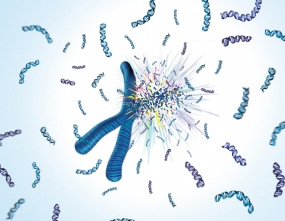CRISPR: “precise scissors” or “chainsaw”?
Scientists do like their metaphors. Like all metaphors they can be criticised for being misleading (see below), but when they affect issues of human and ecological safety, we must be extra careful. In biology, one of the most famous is that of the ‘genetic programme’, which influenced both the directions that research in life sciences took and our perception of the living world. Another is the description of the DNA as the “Book of life”. This linguistic metaphor has been heavily spun recently with the introduction of the CRISPR-Cas9 technology to the toolbox of the biotech industry. CRISPR, we are told, is a tool that would allow the ’editing’ of the genome, it is a ’molecular scissors’ allowing scientists to ‘cut and paste’ etc. All of these metaphors constructs an image of precision and infallibility. The ongoing push for the deregulation of CRISPR-like methods in the agro-industry (see the work of the Corporate Europe Observatory on this) mobilises this supposed infallibility to argue that the genetic manipulation of crops made through CRISPR would only precisely copy what ‘nature’ is doing, and therefore would not warrant any regulation or safety assessment of any sort. This is the argument of ‘indistinguishability’ (see here or here for a critique of this).
One problem with all of this is that CRISPR is not so precise. A 2020 list compiled by Dr Michael Antoniou lists the many studies showing the unintended mutational outcomes (changes made to the DNA molecule) produced by ‘gene editing’ in medical research. In short, when CRISPR is used to modify a genome, it is not unusual that this provokes unintended damage. Until now, the focus was mostly on what are called ‘off-target effects’, that is to say unintended changes can happen in areas different from the one that was targeted.
However, it has recently been acknowledged that there are many unexpected ‘on-target effects’, another major blow to the ‘scissors’ narrative. Not only does the CRISPR system cut at unintended places, but sometimes it does not even cut properly at the intended place… This has been reported for example this year in an April’s study by scientists from the Francis Crick Institute in the UK, which was particularly significant for us, since it dealt with the use of CRISPR in human embryos. An extensive review of these potential on-target effects was produced by GeneWatch UK this September. Their report focuses on the fact that the damage is done not so much by the cutting of the DNA, but that the rejoining (or repair) of the DNA by cellular enzymes after the cut is not properly ‘controlled’. According to the report, “such effects fundamentally challenge the notion of indistinguishability”.
To add to this, in April 2021 as well, a study published in Nature Genetics showed that CRISPR can cause another type of on-target effect that had not been detected before, chromothripsis, which refers to major chromosomal damage of the type that is known to be involved in some cancers. Reporting on this, GMWatch emphasized some interesting facts. One is that the tone of the paper, quite alarmist on a pre-print platform, was turned down a notch at the time of publication. The other is the probable impact on the shares of biotech companies based on CRISPR technologies. As one proponent of these technologies sheepishly reacted in the news section of Nature Biotechnology: “We as a community understand that we’re one serious adverse event away from a clinical hold on everyone”. But, he suggests, all is under control, for the perfect solution for this, the one that technocracy has been given us since its inception, is that: “We will have to mitigate [the unforeseen problems] retrospectively, in reactive mode.”
What is the significance of all this? To quote the GeneWatch report again: “Knowledge of DNA repair pathways is still an evolving field, leaving knowledge gaps and uncertainties around the extent and type of genetic damage being caused, and around any notion of predictability and thus subsequent safety of genome editing applications”. Another take-home message of the report is that scientists will tend to only find what they set out to look for, ignoring the limits of their own detection techniques (e.g. looking only at the site of cut will not allow the detection of off-target effects, looking at point mutations will not allow the detection of chromosomal rearrangements etc.). The result is a kind of cat-and-mouse game between claims of “precision and safety” and the constant discovery of new off- and on-target effects. What a surprise, in October it was shown, again!, that CRISPR gene editing causes whole chromosome loss…
Although Stop Designer Babies’ focus is primarily on the ethical, social and political consequences of allowing human genetic engineering, it is important to take these safety issues seriously. Thirty years of experience with crop and animal genetic engineering has taught us that genetic engineering is rarely ‘precise’ and these ‘unexpected’ effects can have very serious consequences. We simply cannot afford that with human beings, so we need a higher standard of safety there, a precautionary standard. This is particularly clear since there is no medical need to perform such manipulations of the human genome: all medical issues can be dealt with through other technologies that are now widely used and robust. It seems, frankly, crazy, to subject children to such dangerous technologies when simple alternatives are available.
Yet the scientific establishment bodies that keep holding ‘summits’ and proposing paths to clinical trials, rather than asking whether such trials are ever needed, keep pushing ahead regardless. Thus, it falls to critical scientists, doctors and small groups like Stop Designer Babies to speak up for common sense and rationality in the face of scientists’ irrational enthusiasms.
